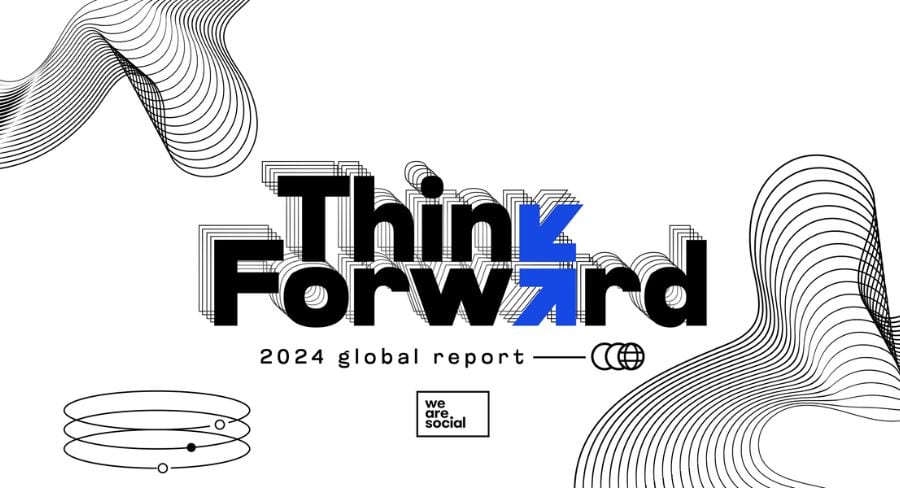We Are Social has launched the latest edition of its annual trends report, Think Forward 2024, examining the changing landscape of social media and its impact on culture and brands.
The report, titled ‘The Social Reckoning’, examines how, in a backdrop of increased commercialisation and commodification, people on social media are rethinking and reframing their worth. They are examining the value derived from their attention and participation, their communities, and their creativity.
Think Forward 2024 explains how this new sense of value has played out across social, from the de-influencing trend helping creators flex what they know, rather than what they have, to the debate around users being able to buy their way into verification on X (formerly Twitter). It argues that cultural phenomena like 2023’s ‘Barbiemania’ demonstrate that people will willingly buy into manufactured hype, as long as it makes space for community, creativity, and play.
The creative agency’s report has highlighted five trends within ‘The Social Reckoning’ theme, exploring how each is expected to shape social media in the next 12 months and demonstrating how brands can use these within their marketing strategies.
Think Forward is compiled by We Are Social’s cultural insights team, gathering insights from teams on the ground across its 19 global markets. This was combined with interviews with external experts to help We Are Social understand broad cultural context, the social media zeitgeist and voices outside the mainstream.
Suzie Shaw, CEO at We Are Social Australia, said: “This year’s Think Forward report highlights the power of culture to truly connect with consumers. But social and culture never sleep and so for brands to successfully navigate the shifting landscape, they must move beyond simple sponsored content, and develop a fluency in culture, focussing on authentically engaging communities and bringing together online and offline conversations and connections.”
The five trends covered in Think Forward 2024 are:
Attention Layering
Having reached peak stimulus with ‘sludge content’, the attention economy is shifting gears. The most forward-thinking users, creators, and culture-leading brands are toying with other modes of bringing people in – ones that turn away from hyper-stimulation.
Example: The viral Wes Anderson aesthetic, which uses the director’s signature style to make everyday scenes – lunch, train rides, uneventful wanders – into an artful visual experience.
Post-Representation
People – whether minorities, disempowered groups, or just users writ large – still value representation. But in today’s culture, there’s less faith in the power of representation alone. As notions of identity compound and deepen, communities want to see messy complexity over neat narratives.
Example: On Reddit, people are using spaces like r/AskBlackGirls, r/AskTransgender, r/AskGayBrosOver30 to help people gain a more nuanced understanding of marginalised groups’ lived reality – but through exploratory, anonymous storytelling rather than loud ‘representation’.
Offline Internet
People are looking for more interaction between on- and offline worlds. Today, characters, communities, and behaviours born on the internet are moving seamlessly into offline worlds. And this interplay isn’t just tolerated – it’s expected.
Example: Drake satirically integrated Snapchat’s iconic ‘crying face’ AR Filter into his live performance of ‘Laugh Now, Cry Later’, turning the faces in the crowd into weeping faces – generating millions of views and earned media for his blurring of real and fake, online and off.
Everyday Fandom
The year of Barbenheimer and the Eras Tour has made it clear: in search of mainstream collectivity, everyday users are acting like ultra-fans. The lines between fan and non-fan are increasingly blurred, as we all engage in fan behaviours and immerse ourselves in collective moments.
Example: IKEA has been tapping into the immensely powerful anime fandom to create scale and grow market share. Its recent back-to-school spot taps into a cultural space popular with Gen Z to establish a meaningful connection with the next generation and become an integral part of their lives.
Mischief Mode
As social media and the internet become more commoditised, users are breaking out of its commercial structures in an attempt to reclaim creativity. Amidst the homogenisation of online spaces, there’s a compelling counter-trend emerging, spearheaded by younger generations.
Example: In order to prove that its products couldn’t be duplicated, haircare brand Olaplex duped the internet with a phoney influencer campaign promoting the fictitious Oladupé No.160. Olaplex championed its range and decried unsavoury business practices, all in one go.
